Acupuncture: History, Uses, and Side Effects
VerifiedAdded on 2023/01/07
|6
|1464
|84
AI Summary
This report provides an overview of acupuncture as a complementary therapy. It discusses the history of acupuncture, its current uses and efficacy, contraindications, side effects, and comparisons with orthodox and traditional treatments. It also explores the regulatory bodies of acupuncture in the UK.
Contribute Materials
Your contribution can guide someone’s learning journey. Share your
documents today.
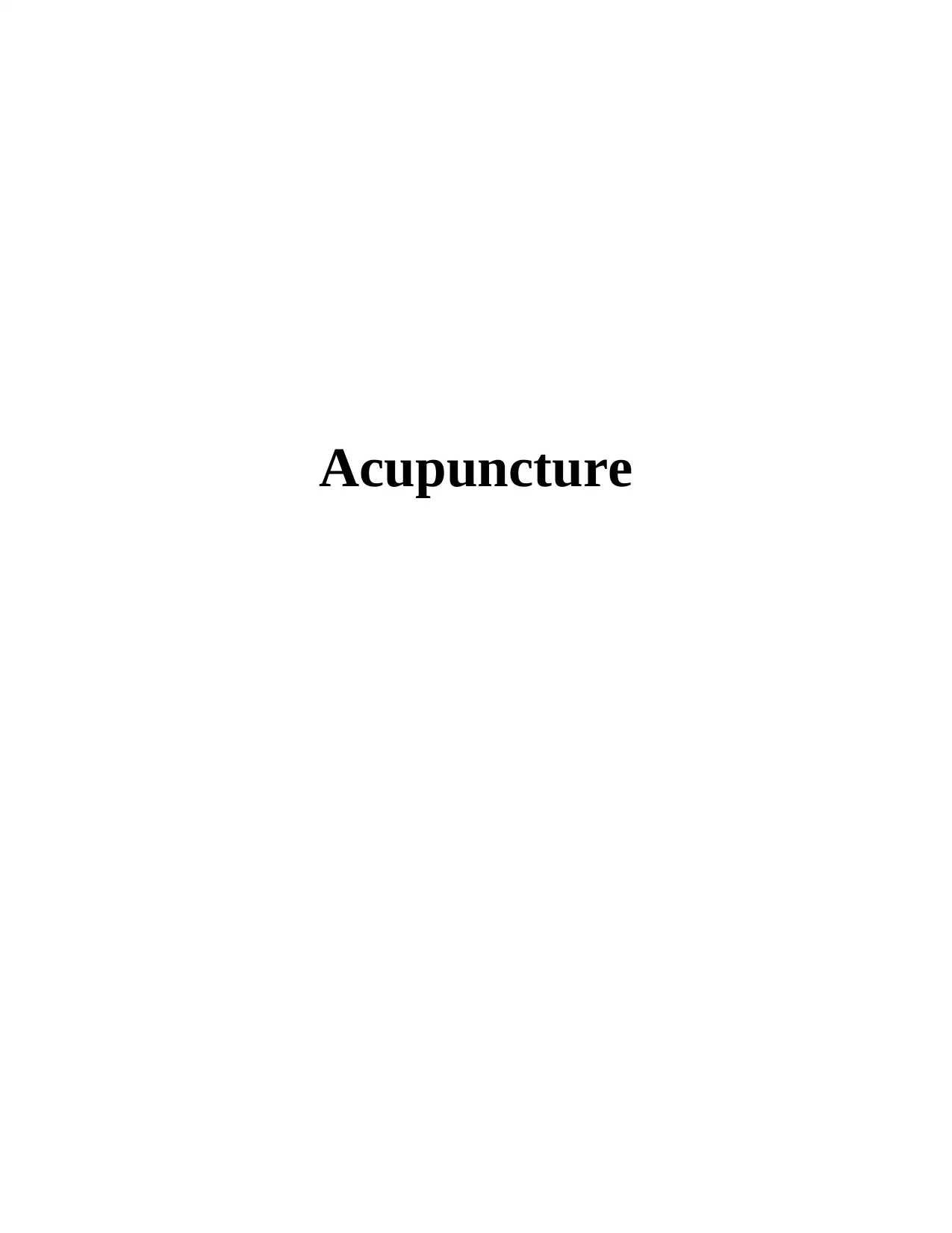
Acupuncture
Secure Best Marks with AI Grader
Need help grading? Try our AI Grader for instant feedback on your assignments.
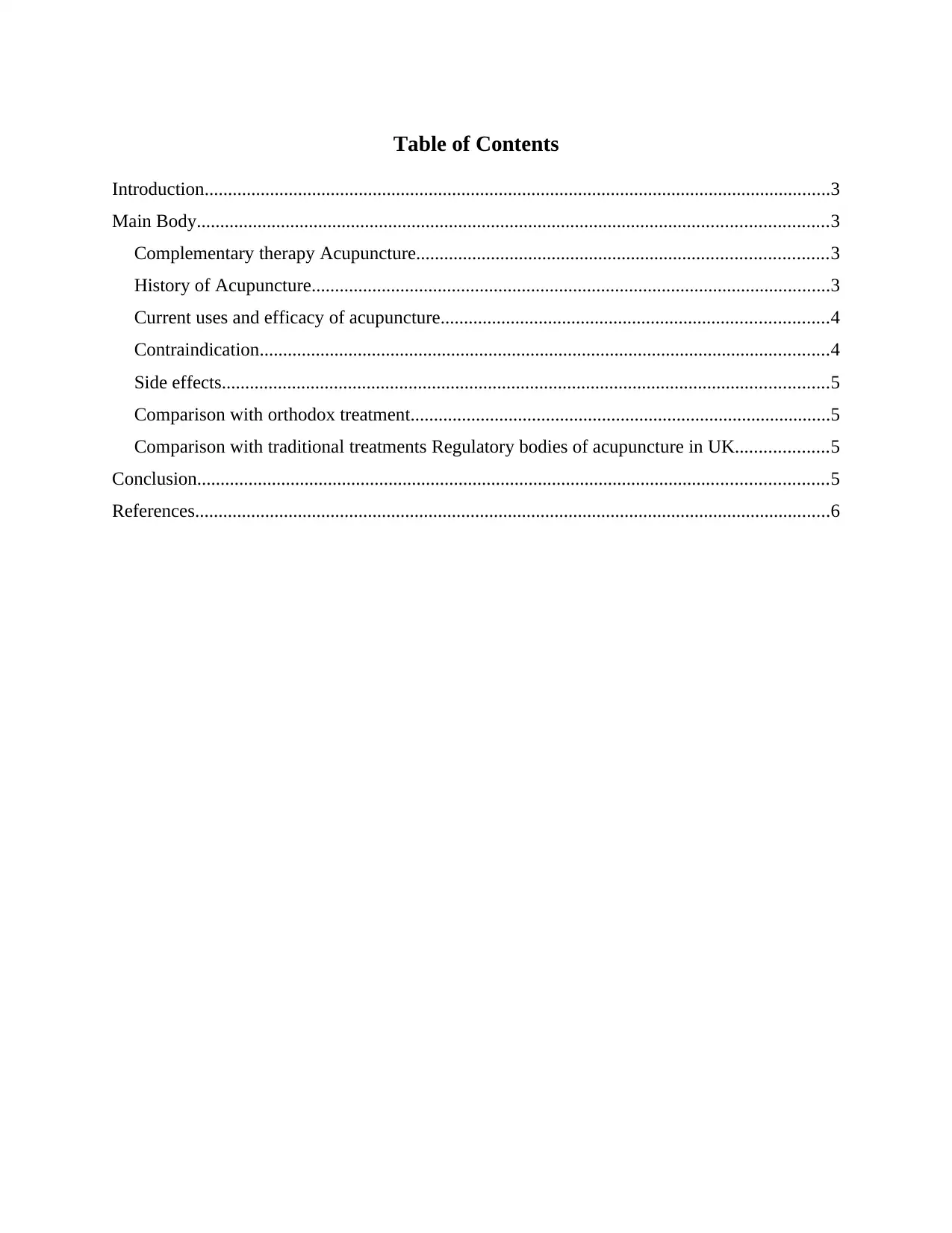
Table of Contents
Introduction......................................................................................................................................3
Main Body.......................................................................................................................................3
Complementary therapy Acupuncture........................................................................................3
History of Acupuncture...............................................................................................................3
Current uses and efficacy of acupuncture...................................................................................4
Contraindication..........................................................................................................................4
Side effects..................................................................................................................................5
Comparison with orthodox treatment..........................................................................................5
Comparison with traditional treatments Regulatory bodies of acupuncture in UK....................5
Conclusion.......................................................................................................................................5
References........................................................................................................................................6
Introduction......................................................................................................................................3
Main Body.......................................................................................................................................3
Complementary therapy Acupuncture........................................................................................3
History of Acupuncture...............................................................................................................3
Current uses and efficacy of acupuncture...................................................................................4
Contraindication..........................................................................................................................4
Side effects..................................................................................................................................5
Comparison with orthodox treatment..........................................................................................5
Comparison with traditional treatments Regulatory bodies of acupuncture in UK....................5
Conclusion.......................................................................................................................................5
References........................................................................................................................................6
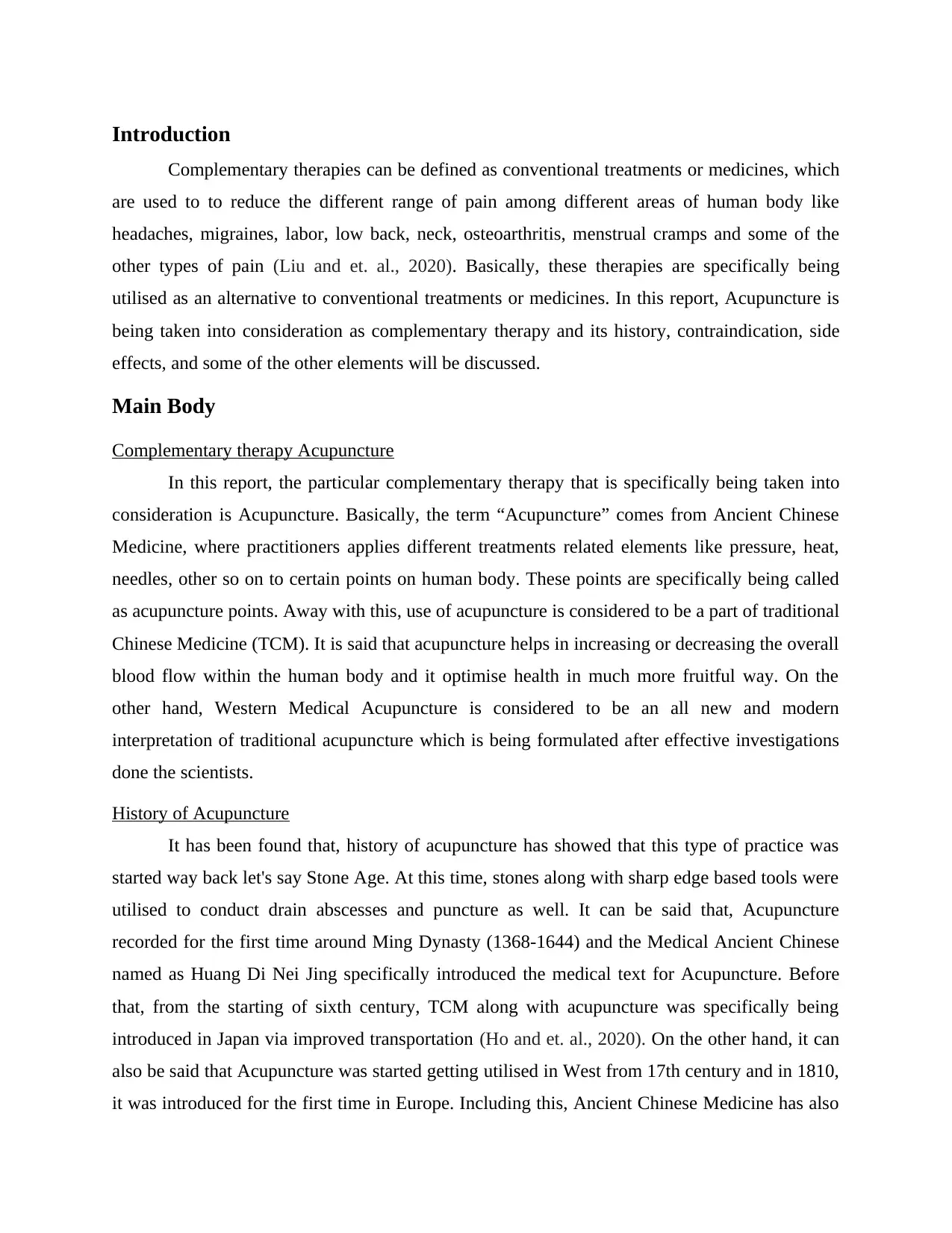
Introduction
Complementary therapies can be defined as conventional treatments or medicines, which
are used to to reduce the different range of pain among different areas of human body like
headaches, migraines, labor, low back, neck, osteoarthritis, menstrual cramps and some of the
other types of pain (Liu and et. al., 2020). Basically, these therapies are specifically being
utilised as an alternative to conventional treatments or medicines. In this report, Acupuncture is
being taken into consideration as complementary therapy and its history, contraindication, side
effects, and some of the other elements will be discussed.
Main Body
Complementary therapy Acupuncture
In this report, the particular complementary therapy that is specifically being taken into
consideration is Acupuncture. Basically, the term “Acupuncture” comes from Ancient Chinese
Medicine, where practitioners applies different treatments related elements like pressure, heat,
needles, other so on to certain points on human body. These points are specifically being called
as acupuncture points. Away with this, use of acupuncture is considered to be a part of traditional
Chinese Medicine (TCM). It is said that acupuncture helps in increasing or decreasing the overall
blood flow within the human body and it optimise health in much more fruitful way. On the
other hand, Western Medical Acupuncture is considered to be an all new and modern
interpretation of traditional acupuncture which is being formulated after effective investigations
done the scientists.
History of Acupuncture
It has been found that, history of acupuncture has showed that this type of practice was
started way back let's say Stone Age. At this time, stones along with sharp edge based tools were
utilised to conduct drain abscesses and puncture as well. It can be said that, Acupuncture
recorded for the first time around Ming Dynasty (1368-1644) and the Medical Ancient Chinese
named as Huang Di Nei Jing specifically introduced the medical text for Acupuncture. Before
that, from the starting of sixth century, TCM along with acupuncture was specifically being
introduced in Japan via improved transportation (Ho and et. al., 2020). On the other hand, it can
also be said that Acupuncture was started getting utilised in West from 17th century and in 1810,
it was introduced for the first time in Europe. Including this, Ancient Chinese Medicine has also
Complementary therapies can be defined as conventional treatments or medicines, which
are used to to reduce the different range of pain among different areas of human body like
headaches, migraines, labor, low back, neck, osteoarthritis, menstrual cramps and some of the
other types of pain (Liu and et. al., 2020). Basically, these therapies are specifically being
utilised as an alternative to conventional treatments or medicines. In this report, Acupuncture is
being taken into consideration as complementary therapy and its history, contraindication, side
effects, and some of the other elements will be discussed.
Main Body
Complementary therapy Acupuncture
In this report, the particular complementary therapy that is specifically being taken into
consideration is Acupuncture. Basically, the term “Acupuncture” comes from Ancient Chinese
Medicine, where practitioners applies different treatments related elements like pressure, heat,
needles, other so on to certain points on human body. These points are specifically being called
as acupuncture points. Away with this, use of acupuncture is considered to be a part of traditional
Chinese Medicine (TCM). It is said that acupuncture helps in increasing or decreasing the overall
blood flow within the human body and it optimise health in much more fruitful way. On the
other hand, Western Medical Acupuncture is considered to be an all new and modern
interpretation of traditional acupuncture which is being formulated after effective investigations
done the scientists.
History of Acupuncture
It has been found that, history of acupuncture has showed that this type of practice was
started way back let's say Stone Age. At this time, stones along with sharp edge based tools were
utilised to conduct drain abscesses and puncture as well. It can be said that, Acupuncture
recorded for the first time around Ming Dynasty (1368-1644) and the Medical Ancient Chinese
named as Huang Di Nei Jing specifically introduced the medical text for Acupuncture. Before
that, from the starting of sixth century, TCM along with acupuncture was specifically being
introduced in Japan via improved transportation (Ho and et. al., 2020). On the other hand, it can
also be said that Acupuncture was started getting utilised in West from 17th century and in 1810,
it was introduced for the first time in Europe. Including this, Ancient Chinese Medicine has also
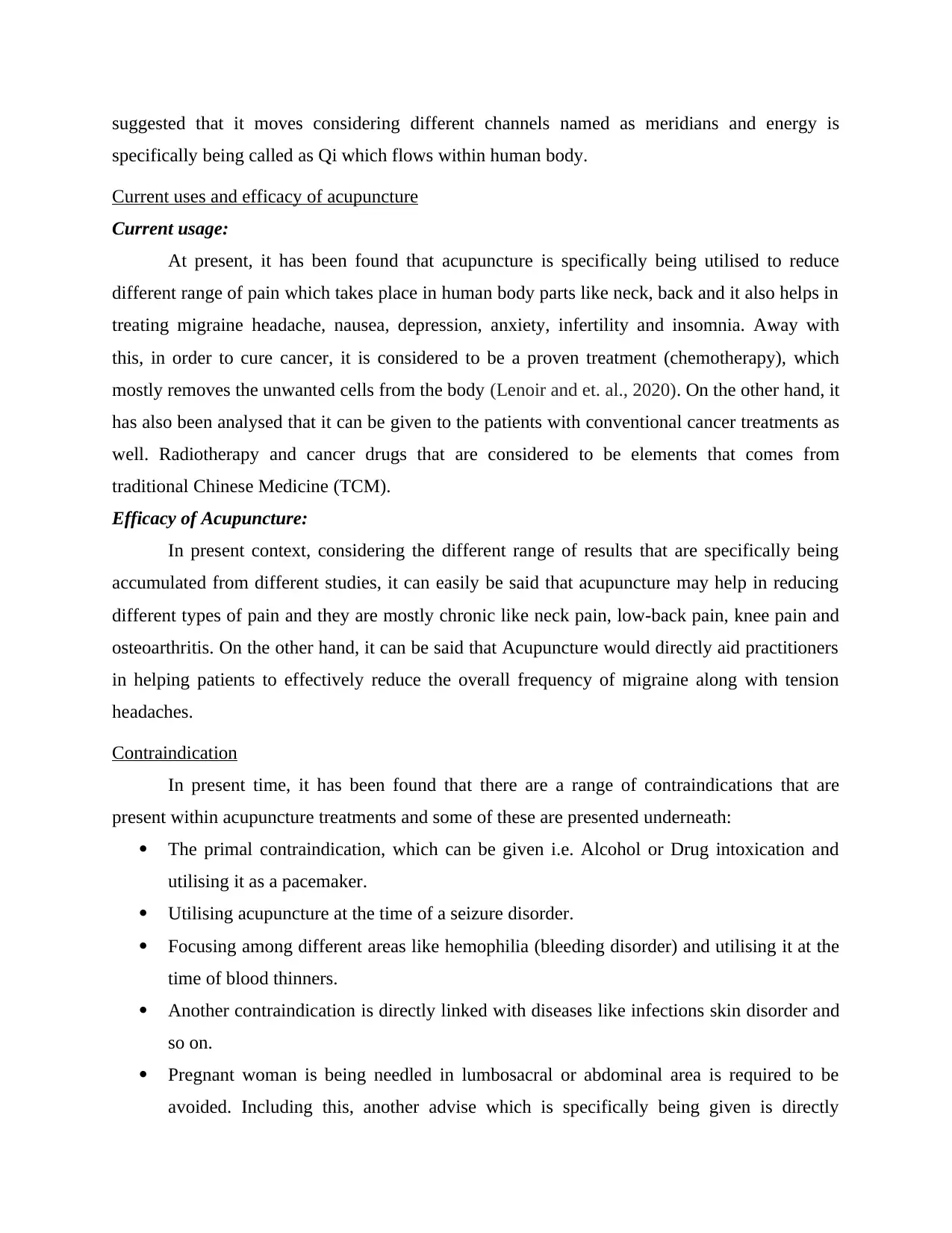
suggested that it moves considering different channels named as meridians and energy is
specifically being called as Qi which flows within human body.
Current uses and efficacy of acupuncture
Current usage:
At present, it has been found that acupuncture is specifically being utilised to reduce
different range of pain which takes place in human body parts like neck, back and it also helps in
treating migraine headache, nausea, depression, anxiety, infertility and insomnia. Away with
this, in order to cure cancer, it is considered to be a proven treatment (chemotherapy), which
mostly removes the unwanted cells from the body (Lenoir and et. al., 2020). On the other hand, it
has also been analysed that it can be given to the patients with conventional cancer treatments as
well. Radiotherapy and cancer drugs that are considered to be elements that comes from
traditional Chinese Medicine (TCM).
Efficacy of Acupuncture:
In present context, considering the different range of results that are specifically being
accumulated from different studies, it can easily be said that acupuncture may help in reducing
different types of pain and they are mostly chronic like neck pain, low-back pain, knee pain and
osteoarthritis. On the other hand, it can be said that Acupuncture would directly aid practitioners
in helping patients to effectively reduce the overall frequency of migraine along with tension
headaches.
Contraindication
In present time, it has been found that there are a range of contraindications that are
present within acupuncture treatments and some of these are presented underneath:
The primal contraindication, which can be given i.e. Alcohol or Drug intoxication and
utilising it as a pacemaker.
Utilising acupuncture at the time of a seizure disorder.
Focusing among different areas like hemophilia (bleeding disorder) and utilising it at the
time of blood thinners.
Another contraindication is directly linked with diseases like infections skin disorder and
so on.
Pregnant woman is being needled in lumbosacral or abdominal area is required to be
avoided. Including this, another advise which is specifically being given is directly
specifically being called as Qi which flows within human body.
Current uses and efficacy of acupuncture
Current usage:
At present, it has been found that acupuncture is specifically being utilised to reduce
different range of pain which takes place in human body parts like neck, back and it also helps in
treating migraine headache, nausea, depression, anxiety, infertility and insomnia. Away with
this, in order to cure cancer, it is considered to be a proven treatment (chemotherapy), which
mostly removes the unwanted cells from the body (Lenoir and et. al., 2020). On the other hand, it
has also been analysed that it can be given to the patients with conventional cancer treatments as
well. Radiotherapy and cancer drugs that are considered to be elements that comes from
traditional Chinese Medicine (TCM).
Efficacy of Acupuncture:
In present context, considering the different range of results that are specifically being
accumulated from different studies, it can easily be said that acupuncture may help in reducing
different types of pain and they are mostly chronic like neck pain, low-back pain, knee pain and
osteoarthritis. On the other hand, it can be said that Acupuncture would directly aid practitioners
in helping patients to effectively reduce the overall frequency of migraine along with tension
headaches.
Contraindication
In present time, it has been found that there are a range of contraindications that are
present within acupuncture treatments and some of these are presented underneath:
The primal contraindication, which can be given i.e. Alcohol or Drug intoxication and
utilising it as a pacemaker.
Utilising acupuncture at the time of a seizure disorder.
Focusing among different areas like hemophilia (bleeding disorder) and utilising it at the
time of blood thinners.
Another contraindication is directly linked with diseases like infections skin disorder and
so on.
Pregnant woman is being needled in lumbosacral or abdominal area is required to be
avoided. Including this, another advise which is specifically being given is directly
Secure Best Marks with AI Grader
Need help grading? Try our AI Grader for instant feedback on your assignments.
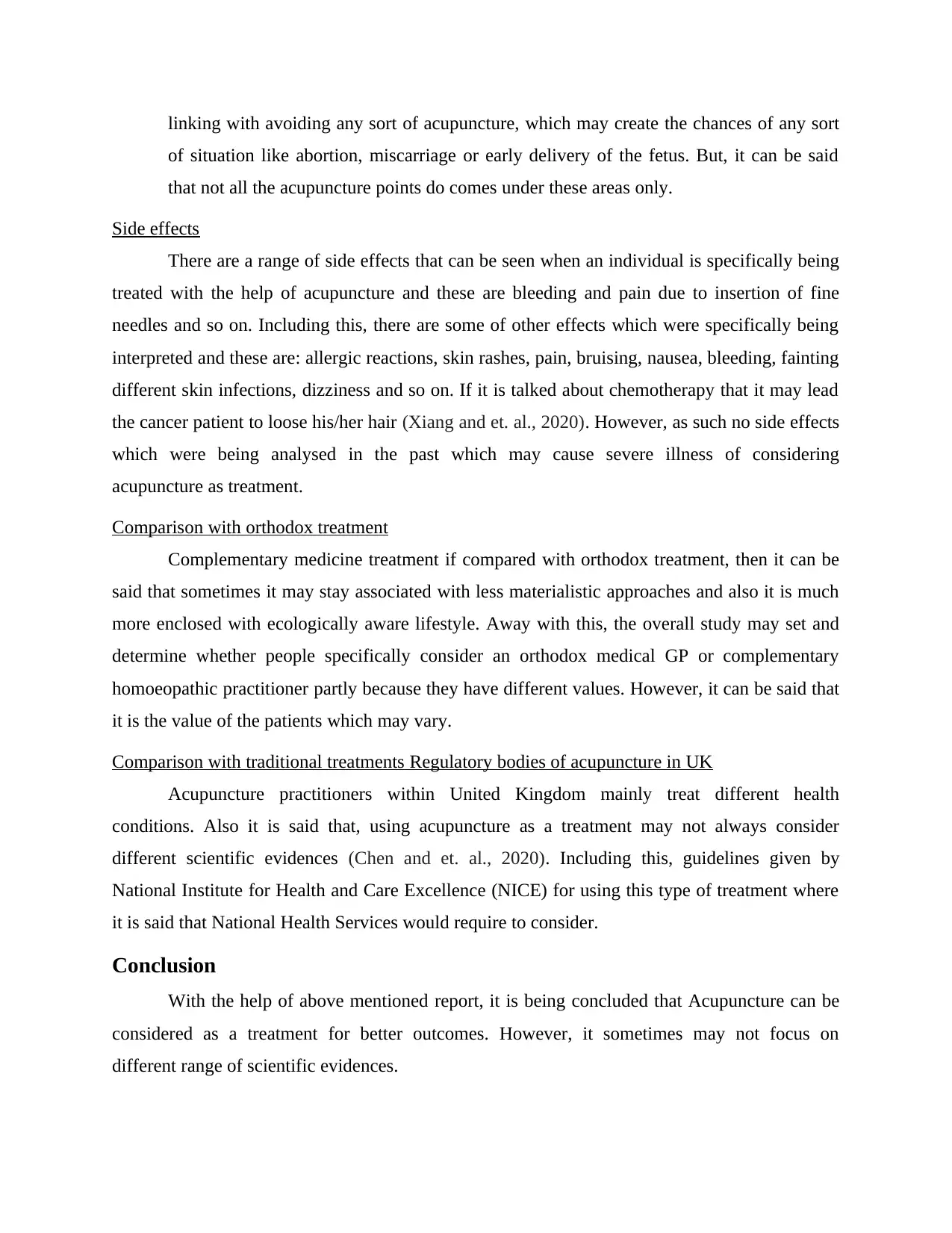
linking with avoiding any sort of acupuncture, which may create the chances of any sort
of situation like abortion, miscarriage or early delivery of the fetus. But, it can be said
that not all the acupuncture points do comes under these areas only.
Side effects
There are a range of side effects that can be seen when an individual is specifically being
treated with the help of acupuncture and these are bleeding and pain due to insertion of fine
needles and so on. Including this, there are some of other effects which were specifically being
interpreted and these are: allergic reactions, skin rashes, pain, bruising, nausea, bleeding, fainting
different skin infections, dizziness and so on. If it is talked about chemotherapy that it may lead
the cancer patient to loose his/her hair (Xiang and et. al., 2020). However, as such no side effects
which were being analysed in the past which may cause severe illness of considering
acupuncture as treatment.
Comparison with orthodox treatment
Complementary medicine treatment if compared with orthodox treatment, then it can be
said that sometimes it may stay associated with less materialistic approaches and also it is much
more enclosed with ecologically aware lifestyle. Away with this, the overall study may set and
determine whether people specifically consider an orthodox medical GP or complementary
homoeopathic practitioner partly because they have different values. However, it can be said that
it is the value of the patients which may vary.
Comparison with traditional treatments Regulatory bodies of acupuncture in UK
Acupuncture practitioners within United Kingdom mainly treat different health
conditions. Also it is said that, using acupuncture as a treatment may not always consider
different scientific evidences (Chen and et. al., 2020). Including this, guidelines given by
National Institute for Health and Care Excellence (NICE) for using this type of treatment where
it is said that National Health Services would require to consider.
Conclusion
With the help of above mentioned report, it is being concluded that Acupuncture can be
considered as a treatment for better outcomes. However, it sometimes may not focus on
different range of scientific evidences.
of situation like abortion, miscarriage or early delivery of the fetus. But, it can be said
that not all the acupuncture points do comes under these areas only.
Side effects
There are a range of side effects that can be seen when an individual is specifically being
treated with the help of acupuncture and these are bleeding and pain due to insertion of fine
needles and so on. Including this, there are some of other effects which were specifically being
interpreted and these are: allergic reactions, skin rashes, pain, bruising, nausea, bleeding, fainting
different skin infections, dizziness and so on. If it is talked about chemotherapy that it may lead
the cancer patient to loose his/her hair (Xiang and et. al., 2020). However, as such no side effects
which were being analysed in the past which may cause severe illness of considering
acupuncture as treatment.
Comparison with orthodox treatment
Complementary medicine treatment if compared with orthodox treatment, then it can be
said that sometimes it may stay associated with less materialistic approaches and also it is much
more enclosed with ecologically aware lifestyle. Away with this, the overall study may set and
determine whether people specifically consider an orthodox medical GP or complementary
homoeopathic practitioner partly because they have different values. However, it can be said that
it is the value of the patients which may vary.
Comparison with traditional treatments Regulatory bodies of acupuncture in UK
Acupuncture practitioners within United Kingdom mainly treat different health
conditions. Also it is said that, using acupuncture as a treatment may not always consider
different scientific evidences (Chen and et. al., 2020). Including this, guidelines given by
National Institute for Health and Care Excellence (NICE) for using this type of treatment where
it is said that National Health Services would require to consider.
Conclusion
With the help of above mentioned report, it is being concluded that Acupuncture can be
considered as a treatment for better outcomes. However, it sometimes may not focus on
different range of scientific evidences.

References
Books and Journals
Liu, T. and et. al., 2020. Acupuncture for Primary Dysmenorrhea: A Meta-analysis of
Randomized Controlled Trials. Alternative Therapies in Health & Medicine, 26(2).
Ho, R. S. and et. al., 2020. Non-specific effects of acupuncture and sham acupuncture in clinical
trials from the patient’s perspective: a systematic review of qualitative
evidence. Acupuncture in Medicine, p.0964528420920299.
Lenoir, D. and et. al., 2020. Acupuncture Versus Sham Acupuncture: A Meta-Analysis on
Evidence for Longer-term Effects of Acupuncture in Musculoskeletal Disorders. The
Clinical Journal of Pain, 36(7), pp.533-549.
Xiang, Y. and et. al., 2020. Evidence of efficacy of acupuncture In the management of low back
pain: a systematic review and meta-analysis of randomised placebo-or sham-controlled
trials. Acupuncture in Medicine, 38(1), pp.15-24.
Chen, Y. Y. and et. al., 2020. Acupuncture versus propranolol in migraine prophylaxis: an
indirect treatment comparison meta-analysis. Journal of neurology, 267(1), pp.14-25.
Books and Journals
Liu, T. and et. al., 2020. Acupuncture for Primary Dysmenorrhea: A Meta-analysis of
Randomized Controlled Trials. Alternative Therapies in Health & Medicine, 26(2).
Ho, R. S. and et. al., 2020. Non-specific effects of acupuncture and sham acupuncture in clinical
trials from the patient’s perspective: a systematic review of qualitative
evidence. Acupuncture in Medicine, p.0964528420920299.
Lenoir, D. and et. al., 2020. Acupuncture Versus Sham Acupuncture: A Meta-Analysis on
Evidence for Longer-term Effects of Acupuncture in Musculoskeletal Disorders. The
Clinical Journal of Pain, 36(7), pp.533-549.
Xiang, Y. and et. al., 2020. Evidence of efficacy of acupuncture In the management of low back
pain: a systematic review and meta-analysis of randomised placebo-or sham-controlled
trials. Acupuncture in Medicine, 38(1), pp.15-24.
Chen, Y. Y. and et. al., 2020. Acupuncture versus propranolol in migraine prophylaxis: an
indirect treatment comparison meta-analysis. Journal of neurology, 267(1), pp.14-25.
1 out of 6
Related Documents
Your All-in-One AI-Powered Toolkit for Academic Success.
+13062052269
info@desklib.com
Available 24*7 on WhatsApp / Email
![[object Object]](/_next/static/media/star-bottom.7253800d.svg)
Unlock your academic potential
© 2024 | Zucol Services PVT LTD | All rights reserved.





